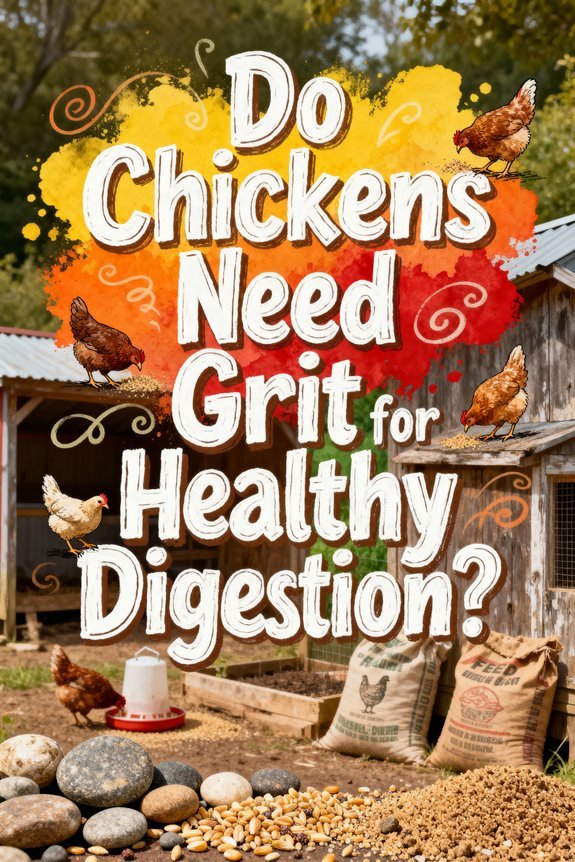Can Chickens Safely Eat Cheese as a Treat?
You can safely feed cheese to chickens as an occasional treat, but you’ll need to follow proper portion control guidelines. Offer small amounts (1-2 cubic pieces) 2-3 times weekly, ensuring it doesn’t exceed 10% of their total diet. Choose aged or goat cheese varieties, which are lower in lactose and easier to digest. Monitor your flock for signs of dairy intolerance, such as diarrhea or lethargy. Understanding proper cheese selection and feeding practices will help maximize this treat’s nutritional benefits.
Nutritional Value of Cheese for Chickens
Cheese offers significant nutritional benefits when fed to chickens as an occasional treat. You’ll find it’s an excellent protein source, containing about 24 grams per 100 grams, primarily as highly bioavailable casein. This protein supports muscle maintenance and growth in your flock while enhancing mineral absorption. Like raw almonds, cheese can be offered as part of a balanced diet for immune system support.
The nutritional benefits extend beyond protein, as cheese sources provide essential calcium vital for bone strength and eggshell quality in laying hens. You’ll also find valuable vitamins and minerals, including Vitamin D for calcium metabolism and potassium for general health. The fat content, while high at 33.8 grams per 100 grams, aids in absorbing fat-soluble vitamins and provides energy. For best digestibility, consider aged or goat cheese varieties, which contain less lactose and are gentler on your chickens’ digestive systems. Feeding phosphorus-rich cheese to your flock can help prevent thin, soft eggshells common in mineral-deficient birds.
Safe Feeding Practices and Portion Control
While cheese provides valuable nutrients for chickens, proper portioning and feeding practices determine its safety and effectiveness as a treat. You’ll need to limit cheese types to small, manageable portions of 1-2 cubes (approximately 1/2 inch) per chicken, offered 2-3 times weekly. Start with pea-sized amounts to assess tolerance before increasing portion limits. The treat helps ensure adequate calcium during peak egg production seasons. Like the Araucana breed, chickens require careful attention to diet and nutrition for optimal egg production. Maintaining a diet based on quality layer feed ensures proper nutrition while offering occasional treats.
Monitor your chickens closely after introducing cheese treats. Serve during daylight hours and remove any uneaten portions promptly to prevent spoilage. Don’t exceed 10% of their overall diet with cheese treats, as overconsumption can lead to obesity and digestive issues. Make certain the cheese is fresh, mold-free, and low in sodium. Always maintain clean feeding areas and provide fresh water to support proper digestion.
Signs of Dairy Intolerance in Chickens
Recognizing dairy intolerance in chickens requires careful observation of both digestive and behavioral symptoms. You’ll notice signs like diarrhea, bloating, and abdominal discomfort when your chickens can’t properly digest lactose. Through symptom observation, you might detect lethargy, reduced feed intake, or changes in stool consistency hours or even days after dairy consumption. Just as with humans, symptoms typically appear a few hours after consuming dairy products.
Age plays an essential role in enzyme production, as older chickens produce less lactase, making them more susceptible to intolerance. While younger birds may handle small amounts of dairy better, mature chickens often show more pronounced digestive disruption. It’s important to distinguish these symptoms from allergic reactions, as dairy intolerance primarily affects the digestive system rather than causing respiratory or skin reactions typical of true allergies.
Best Types of Cheese for Chicken Treats
When selecting dairy treats for your flock, certain types of cheese prove more suitable than others due to variations in lactose content and digestibility. Goat cheese ranks among the best options, containing lower lactose levels that chickens can process more easily. You’ll also find cottage cheese to be a beneficial choice, offering substantial calcium for laying hens, though it should be served sparingly due to its lactose content. Moldy blue cheese can provide beneficial bacteria to support chicken gut health.
Just as chicken wire fencing effectively protects gardens from foraging birds, proper portion control helps safeguard your flock’s health when feeding cheese treats.
Offering cheese as an occasional protein boost can complement their essential amino acids found in regular layer feed. For ideal safety and consumption, serve hard cheeses grated or thinly sliced, while soft varieties can be offered in small, manageable portions. Focus on plain, natural varieties without added ingredients like herbs or garlic that could harm your birds. Remember to provide fresh water alongside any cheese treats, and always maintain moderation to prevent digestive issues or nutritional imbalances.
Health Risks of Overfeeding Cheese
Through careful observation, chickens can develop serious health complications from overfeeding cheese, despite its nutritional benefits in moderation. When overfed, cheese’s complex fats and proteins overwhelm their digestive systems, leading to digestive distress including diarrhea, bloating, and dehydration. You’ll notice obesity risks increase, compromising mobility and heat regulation. Most chickens may seem eager to eat unlimited cheese since many birds will overeat given time.
Watch for cheese allergies, which manifest as respiratory issues, lethargy, and skin irritations. Reproductive problems can arise, including decreased fertility and egg-binding, particularly in overweight hens. You’ll see poor egg quality and potential bloodstains when nutritional imbalances occur from excess cheese consumption.
To protect your flock’s health, limit cheese treats to less than 10% of their total diet. This restriction helps maintain proper nutritional balance and prevents these adverse health effects.
Combining Cheese With Other Healthy Treats
By combining cheese with nutritionally diverse treats, you’ll create a more balanced and engaging feeding experience for your chickens. Consider fruit pairings like bananas and pumpkin, which provide antioxidants and vitamins that complement cheese’s protein and calcium content. Vegetable mixes incorporating leafy greens, peas, and squash add essential fiber and micronutrients to cheese-based treats. Remember that treats should constitute no more than 5% of your chickens’ total diet to maintain optimal health. Adding butternut squash provides excellent vitamin A benefits while serving as a natural deworming option.
You can create nutritious combinations by mixing cheese with whole grains, fresh herbs, or lean proteins. Try recipes like herb-cheese fritters or banana oatmeal treats that incorporate multiple healthy ingredients. When combining ingredients, maintain moderation and introduce new combinations gradually. This approach guarantees proper nutrient balance while allowing you to monitor your flock’s response to different treat mixtures. Adding baked flock blocks made with molasses and sunflower seeds can provide sustained entertainment while supplementing their nutritional needs.
Managing Digestive Health When Feeding Cheese
Proper digestive health management stands at the forefront of successful cheese feeding practices for chickens. Since chickens lack digestive enzymes for processing lactose, you’ll need to choose cheese types carefully. Opt for aged or processed varieties with minimal lactose content to reduce the risk of diarrhea and digestive upset.
Monitor your chickens closely when introducing cheese to their diet. Watch for signs of digestive distress, including loose droppings or reduced appetite. If you notice any adverse reactions, immediately stop feeding cheese and consult a veterinarian. Consider feeding them high-quality treats as a safer alternative. Like their regular dust bathing behavior, maintaining digestive health is essential for your chickens’ overall wellbeing. To support gut health, consider combining cheese treats with natural supplements like oregano or thyme oils, which can help maintain beneficial gut bacteria. Remember that moderation is vital – small portions of low-fat cheese options will help prevent digestive strain and maintain your flock’s gastrointestinal balance.
The Role of Cheese in a Balanced Chicken Diet
Integrating cheese into your chickens’ diet requires careful consideration of nutritional balance and portion control. While cheese offers valuable supplemental protein and immune support through its rich vitamin and mineral content, it shouldn’t replace your birds’ primary feed sources. You’ll want to incorporate it alongside their regular diet of grains, seeds, vegetables, and formulated pellets. Your chickens will likely be drawn to cheese due to its salty and tangy flavors. When feeding cheese to your flock, vent sexing experts recommend carefully observing each bird’s individual response since males and females may process dairy differently.
For laying hens, cheese’s calcium content can enhance eggshell quality, but moderation is key. Use it as an occasional treat rather than a daily staple to prevent nutritional imbalances. Treats like cheese should be limited to 15 percent of their total diet. The protein in cheese, particularly casein, supports mineral absorption and egg production, while its diverse nutrient profile contributes to overall health. Remember to observe your flock’s response when introducing cheese, as individual birds may have varying tolerance levels.
Monitoring Your Flock’s Cheese Consumption
Successful monitoring of cheese consumption in your flock requires five essential tracking components: portion control, health indicators, behavioral changes, nutritional balance, and systematic record-keeping.
To evaluate dairy safety, you’ll need to establish baseline serving sizes based on your chickens’ weight and age, then track their responses through detailed observations. Monitor their droppings, energy levels, and overall health for signs of lactose intolerance or digestive issues. Document any changes in regular feed intake and flock dynamics that might indicate cheese impact. Similar to how antimicrobial use monitoring helps prevent health issues in chicken farms, careful tracking of cheese consumption can identify potential problems early.
Maintain consistent records of treat frequency, portion sizes, and cheese types using standardized measurements. Cross-reference this data with your flock’s overall nutritional intake and adjust accordingly. Use spreadsheets or apps to track temporal patterns and identify trends that could affect your chickens’ well-being.
Tips for Serving Cheese to Your Chickens
Safe cheese serving practices can maximize nutritional benefits while minimizing health risks for your chickens. When crafting cheese recipes, shred or thinly slice harder varieties like cheddar, while soft cheeses can be offered in small chunks. Remove any inedible rinds, wax coatings, or plastic coverings before serving.
Establish a controlled feeding schedule that limits cheese treats to occasional offerings. You’ll want to mix small amounts with their regular feed to provide balanced nutrition. Just as with raw beans, moldy or spoiled cheese can be toxic to chickens. Don’t serve moldy, fermented, or spoiled cheese, and avoid varieties with artificial flavors or excessive salt. Always provide fresh water alongside cheese treats to support proper digestion. Monitor your flock closely after introducing new cheese varieties, and discontinue if you observe any signs of digestive distress.


